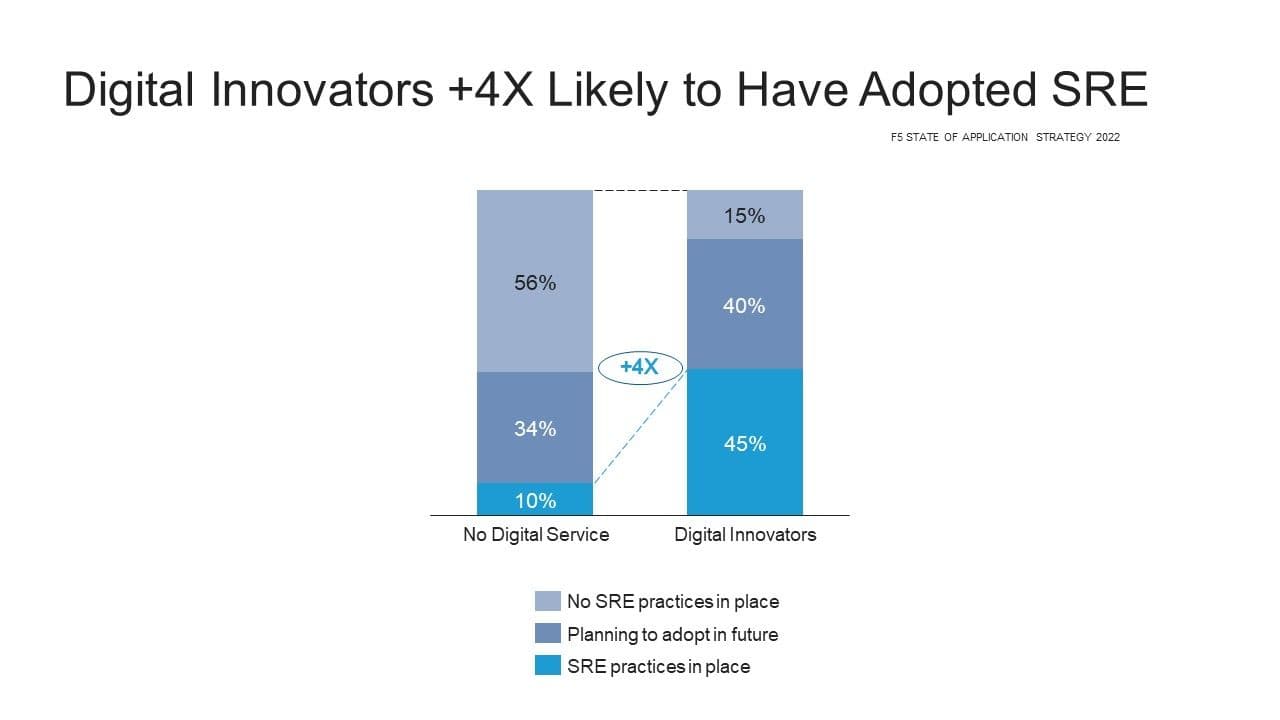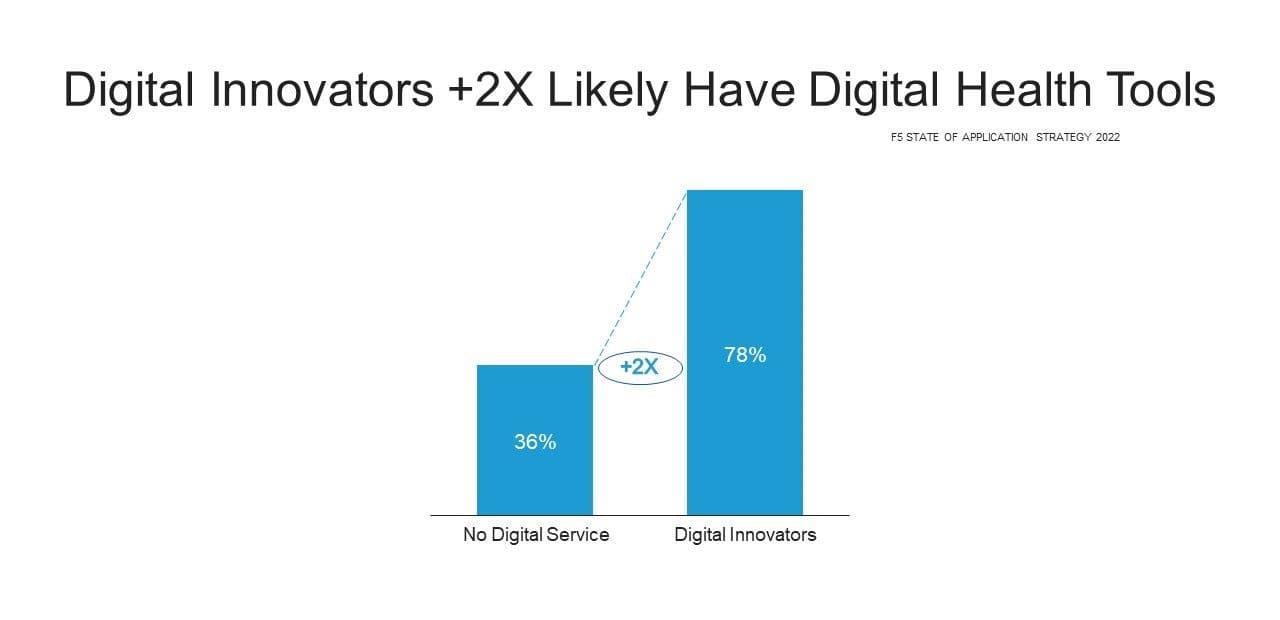This year’s State of Application Strategy Report aims to uncover what it takes to be a digital transformation leader. Digital transformation leaders are at the forefront for how they interact with customers, how their organizations create products and services, and how their internal operations teams and technology stack deliver these experiences. In our deeper look, we found that 82% of organizations are having digital interactions with their customers, patients, partners, suppliers, constituents, and students in addition to their own internal employees—we call them Digital Innovators.
Digital Innovators are not just purchasing technology, they approach digital transformation with a strategic mindset, connecting the dots between the technology capabilities required to deliver their desired business outcomes. They have started to change the way they operate and do business because digital initiatives across all business functions offer the promise of faster rates of innovation, higher market share gains, and greater operational efficiencies.
As Lori MacVittie mentions, this year we see serious attention being paid to the technology side of delivering on the business promise of digital transformation. Our research uncovered specific examples of how these digital innovators are adopting new technologies and processes, with the expectation that leaders in respective industries will see their successes followed and copied. Let's take a look...
Modernizing Operations
Site Reliability Engineering (SRE) practices enable the automation of processes at scale across the disciplines of development and operations with the goal of delivering on the business need for agility, security, and performance. Connecting the dots on the importance of SRE practices and digital innovation, we found 45% of Digital Innovators have adopted SRE practices compared to only 10% of those without digital services—a 4X difference in adoption. It’s clear that operational investments stand out among all digital transformation priorities, with over $620 billion in spending expected this year according to IDC.

Leading Approach to Risk Management
Advanced digital businesses know that they must take a pragmatic approach to risk management. These organizations are utilizing data to make appropriate choices between security and the business need to create fast, compelling digital interactions. One lens into risk management is to understand if organizations are making tradeoffs between security and app performance. In fact, we found that 76% of Digital Innovators would be enticed to turn off some elements of security if the benefit was app performance improvements, compared to only 63% of those who are not offering digital services beyond their organization. These Digital Innovators are balancing the needs of the business in real time for an exceptional customer experience and the necessity of protecting the organization from threats.
Digital transformation changes how companies create value and, in this new way of doing business, value comes from how the organization interacts with external partners or customers. APIs are the way that a digital business delivers on these interactions, and securing these APIs is paramount. We found that Digital Innovators are much further along in API security adoption, with 87% currently adopting or planning to adopt API security compared to only 43% among those who are not offering digital services.
To make informed choices such as selectively turning off elements of security for performance gains or understanding the importance of API security, digital leaders need to have insights from data. Digital Innovators are using data and insights about application health, performance, and security to measure the impact applications have on the customer and employee experience and the business. Among Digital Innovators, 78% indicated they have the tools needed to report on the health of high-priority business applications compared to only 36% among those who are not offering digital services. Similarly, Digital Innovators are far more likely to prioritize metrics to demonstrate service level agreements and reporting capabilities to business leadership.

Looking to the Edge to Support Global Scale
Looking to leverage the wealth of innovations available, this group of Digital Innovators are 5X more likely to report that they are adopting edge for creating or expanding customer reach for global on-demand scale. With a keen focus on business goals, they are utilizing the edge at greater rates to improve customer experiences with better app performance. Not surprisingly, these are the organizations who are leading in understanding how to best realize value from each of the large cloud providers, with 80% reporting they are utilizing multiple cloud providers compared to only 36% among those who are not providing digital services.
Conclusion
Digital Innovators are creating differentiation and are at the forefront of discovering how technology can deliver business value. They recognize the importance of the edge to deliver app performance and global scale while taking a modern approach to operations and security. At the core they are using data and insights to deliver the digital experiences the business requires. They are ensuring that technology is moving at the speed of the business. Another reason Digital Innovators are moving fast (and one that didn’t make it into our final report)? The data also shows they are twice as likely to consume caffeine than those who are not offering digital services. #nowyouknow
Check out related blogs for deeper dives on select topics:
State of Application Strategy 2022: Unpacking 8 Years of Trends ›
State of Application Strategy 2022: Security Shifts to Identity ›
State of Application Strategy 2022: Edge Workloads Expanding to Apps and Data ›
State of Application Strategy 2022: Multi-Cloud Complexity Continues ›
State of Application Strategy 2022: Performance Trends ›
State of Application Strategy 2022: Time to Modernize Ops ›
State of Application Strategy 2022: The Future of Business Is Adaptive ›
About the Author

Related Blog Posts

AppViewX + F5: Automating and orchestrating app delivery
As an F5 ADSP Select partner, AppViewX works with F5 to deliver a centralized orchestration solution to manage app services across distributed environments.

Build a quantum-safe backbone for AI with F5 and NetApp
By deploying F5 and NetApp solutions, enterprises can meet the demands of AI workloads, while preparing for a quantum future.

F5 ADSP Partner Program streamlines adoption of F5 platform
The new F5 ADSP Partner Program creates a dynamic ecosystem that drives growth and success for our partners and customers.
F5 NGINX Gateway Fabric is a certified solution for Red Hat OpenShift
F5 collaborates with Red Hat to deliver a solution that combines the high-performance app delivery of F5 NGINX with Red Hat OpenShift’s enterprise Kubernetes capabilities.
F5 Silverline Mitigates Record-Breaking DDoS Attacks
Malicious attacks are increasing in scale and complexity, threatening to overwhelm and breach the internal resources of businesses globally. Often, these attacks combine high-volume traffic with stealthy, low-and-slow, application-targeted attack techniques, powered by either automated botnets or human-driven tools.
Phishing Attacks Soar 220% During COVID-19 Peak as Cybercriminal Opportunism Intensifies
David Warburton, author of the F5 Labs 2020 Phishing and Fraud Report, describes how fraudsters are adapting to the pandemic and maps out the trends ahead in this video, with summary comments.
